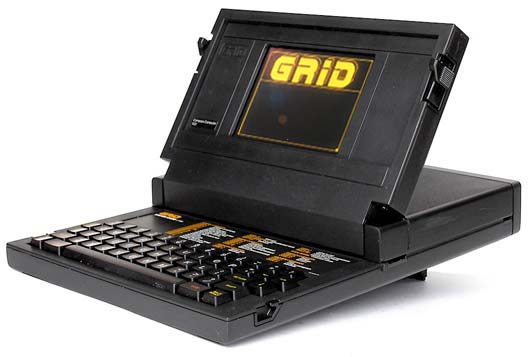Today, we take laptops for granted. If you’re willing to put up with a small screen and possibly use Chrome OS instead of Windows, you can get one for under $200. But, it wasn’t that long ago that the idea of a laptop was the stuff of science fiction. And then, the world changed.
This looked futuristic then, and kinda still does.

It was called the Grid Compass. If you had $10,000 to spend in 1979, you could pick up two mid-size cars or one of these, which has the distinction of being the first laptop computer. We call it a laptop since it had the basic shape of a laptop today: flat screen that folds up to reveal a keyboard and a shape and weight that won’t crush your femur. To say that it was a working computer by today’s standards… that’s another thing.
The Grid Compass gave you a screen about 1/16 as detailed as an iPhone’s, with one color: orange. It would have stored about 10 seconds of music or a picture about an inch by an inch. Of course in 1979 that was less of a problem, especially for the US government who bought them by the palette-load to use in the space program. It was one of the most powerful computers of any size or shape back then, even though it’s not so impressive now.
Still, there’s something about it that makes it look important. It looks like it could be used on a spaceship, despite being clunkier and heavier than today’s ubiquitous laptops.
And yes, it was small for the day
Its small size was especially astounding because its closest competitor, the “portable” Osborne 1, was a little smaller than a small office copier and weighed 30 pounds. It was much more durable than today’s laptops, but then at 12 pounds it probably had a lot more metal than your average iPad. And believe it or not, back in 1979 it was the state of the art
The idea of a computer small enough to carry with you started in the late 1960s, when Alan Kay proposed something he called a “Dynabook,” a revolutionary concept describing a computer that weighed less than four pounds, had a screen that was the same quality as a printed page, that could store books, music and media and connect to some outside source to get more information than needed.
That’s right. Dr. Kay invented the iPad, back in 1968. Of course it took forty years to make it affordable, which was the last bit of the puzzle. Even if it were possible to build an iPad in 1968 (it wasn’t) it probably would have cost billions of dollars!
The first step in making the Dynabook a reality was the Grid Compass, and we’re grateful that it came, because if it hadn’t, we might all be carrying around fifty-pound iPads!
Solid Signal doesn’t sell laptops…
But we do sell just about everything else you’ll need to live your best digital life. Shop now for the parts and accessories you’ll need! Need help? Call us at 888-233-7563 during East Coast business hours. If it’s after hours, fill out the form below. We’ll get back to you, usually within one business day.





